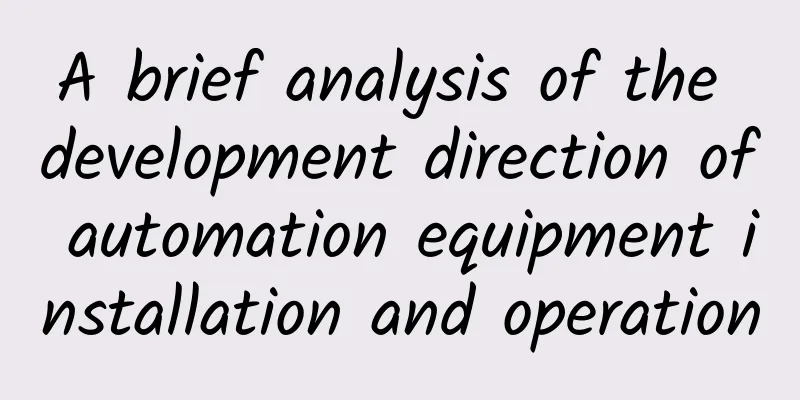A brief analysis of the development direction of automation equipment installation and operation

|
IT operation and maintenance automation refers to automating the daily, large-scale repetitive work in IT operation and maintenance, and converting the previous manual execution into automated operations. Automation is the sublimation of IT operation and maintenance work. IT operation and maintenance automation is not just a maintenance process, but also a management improvement process. It is the highest level of IT operation and maintenance and is also the future development trend.
With the advancement of operation and maintenance technology and the improvement of the operation and maintenance service system, automated operation and maintenance, as a dynamic direction, has also ushered in new challenges and changes with the changes in scale and scenarios. The scope of operation and maintenance activities is more above the hardware and operating system and below the application. It and the infrastructure are like the two legs of a person, complementing each other and always moving forward alternately. The infrastructure determines the direction of operation and maintenance, and the operation and maintenance system also enables the infrastructure to achieve the best benefits. Therefore, the essence of the automated operation and maintenance platform is not to simply make the operation interface so that people can manage the system by simply clicking buttons on the interface, but to build a good bridge between the underlying infrastructure and the upper-level business system, so that the business system can be fully and stably operated without having to pay too much attention to the characteristics of the underlying architecture. The goal of automated operation and maintenance is no longer just to eliminate faults and clean up equipment. Instead, it is a special service that can intervene during business development and run with the entire business. The application itself can meet the requirements of reliable operation and maintenance under the corresponding infrastructure, whether it is a unified operation and maintenance status interface, disaster recovery, automatic scaling, and relationship adjustment during changes. The development of virtualization and cloud computing has brought about further changes in operation and maintenance services. Small and medium-sized companies no longer have to consider issues such as disaster recovery and backup. On-demand resource trading not only eliminates resource waste, but also makes scaling easier and more economical when adjusting business. It has greatly simplified the traditional operation and maintenance work and is an important trend for the development of small and medium-sized Internet companies in the future. At this time, the focus of operation and maintenance work will shift to the selection and optimization of platform architecture. Operation and maintenance needs to pay more attention to business characteristics and related technical systems, and help R&D decide on the selection of various cloud services and evaluate their applicability to the business. In the foreseeable future, the role of operation and maintenance will become increasingly important. The key to this increased importance lies in the changes in the participation and position of operation and maintenance in the entire technical system. The rise of automated operation and maintenance has brought operation and maintenance personnel, who were traditionally in the back-end service, to the forefront of service. Although simple fault tracing and service guarantee still account for part of the operation and maintenance work, with the development of automated operation and maintenance technology, operation and maintenance personnel have more energy and conditions to invest in the sorting and design of the entire service architecture, and even participate in the research and development process by providing basic components, making the product inherently highly operable. R&D should pay attention to operation and maintenance, and operation and maintenance should be able to intervene in R&D. Roles with equal capabilities should cooperate and be responsible for different fields and directions. This is the inevitable division of labor under the large system of technological development. It is also the inevitable way for operation and maintenance to get rid of hard labor and continue to move towards deeper technological development. |
<<: Facing these possible accidents, is your operation and maintenance team ready?
>>: Why is WiFi on buses not as popular as on subways?
Recommend
iWebFusion: Dedicated server starting at $57/month/5 data centers available, 10Gbps server starting at $149/month
iWebFusion (iWFHosting) has been shared many time...
How does Beijing’s government cloud build the city’s “strongest brain”?
On July 15, 2016, Huawei's Smart City Ecosyst...
Network Technology Outlook 2023: Virtual Networks Will Drive NaaS Development, Cloud-Hosted Security Options Will Explode
What are the most important things that enterpris...
What to do if the HTTPS certificate is forged?
The security of the HTTPS protocol relies on its ...
Is our 5G field booming? Many regions are actively deploying, and the future development potential is worth paying attention to
As an important direction for the evolution and u...
drServer: Dallas unlimited dedicated servers starting at $12/month
drServer is a foreign hosting company founded in ...
Spain's 5G state subsidies may exclude Huawei, Huawei appeals
On October 10th, local time on Monday, Huawei app...
2017 Huawei Cloud Industry Summit Forum: Building an "Urban Industry Cloud" Alliance to Boost the Leapfrog Development of Cities
[51CTO Suzhou Report] On June 9, 2017, the 2017 H...
WiFi will be replaced in the future, what do you think?
WIFI is really going to be replaced! But it's...
Justhost offers 20% off on US data centers, 200M unlimited traffic starting at $1.65/month
The last time I shared information about Justhost...
Learn more about Zero Trust Network Access (ZTNA)
Traditional perimeter-based network protection co...
Prefabricated Data Centers – Winning Edge Data Centers
Speed is critical for data. Data is being gener...
OlinkCloud: $5.6/month KVM-1GB/10G SSD/500GB/San Jose
Tribe shared the news about Olink.Cloud in Novemb...
Sharktech: Los Angeles high-defense 1Gbps unlimited traffic server starting at $79/month, 10Gbps unlimited traffic starting at $379/month
Sharktech is a long-established hosting company f...









